Eventually, by moving the car a few feet at a time and then stopping for a while, I managed to get fairly close to the flock and take some pictures. The Little Terns hogged all the best spots at the pool, and busily splashed, preened, and every now and again would take off in a needless panic, only to wheel around and land again sheepishly.

The stints, Curlew Sandpipers and sand plovers stood around or rested on their bellies on the sand. They mix freely with one another and don't seem to show any preference for their own kind. The knots are much more exclusive however, sitting close together and apart from the other species. The two Red Knot hung about with their larger cousins.
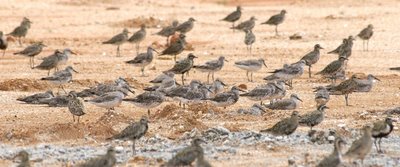
The exclusive Knot Club! There's a lone Red Knot toward the right of the group, back toward us, looking over its shoulder. Red Knot are smaller, shorter-legged and billed than Great Knot.
A few Terek Sandpipers wandered through the resting flocks, dipping their bills in the water, preening and, occasionally resting.

The rest of the roost was made up by Pacific Golden Plovers, a few Bar-tailed Godwits and Whimbrels, and Ruddy Turnstones. Most exclusive of all, however, are the Greenshanks. They always seem to roost by themselves, well away from all the other waders.
At the back of the flock I spotted a Red-necked Stint with what appeared to be a yellow spot attached to its wing. Wing-tagging is one way of marking birds for research purposes, enabling them to be recorded on migration by birdwatchers, so that a picture can be drawn of migration routes, favoured staging sites, etc. This information becomes important baseline data for conservation efforts. I've sent off details of this bird to researchers in Australia, who in turn have forwarded it to colleagues in Russia, but so far, no one has been able to tell me where the bird got its tag from.

Once the tide started to fall, I got myself into position on the mud. A juvenile Little Heron landed very close by and was clearly suspicious. It would continually make disapproving clucking noises while bobbing its head and peering in my direction. Eventually it must have decided I was just a harmless lunatic, and began to hunt for prey in the nearby pools. I could see some vestigial down attached to its head and breast, so it was probably a very young bird.
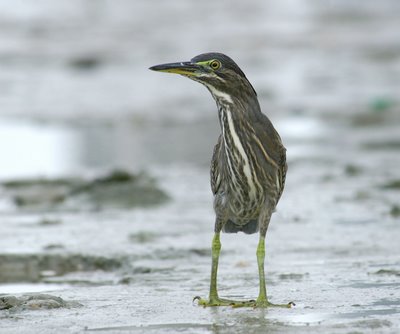
A small group of Greenshanks landed on the tide-line and began chasing around after fish fry. They would put their open bills into the water and then run along sweeping them from side to side, as I have seen Avocets do in my native UK. Marsh Sandpipers sometimes also feed in this way here.
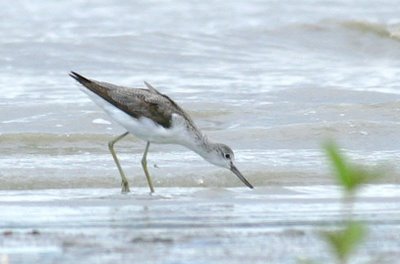
An adult Greenshank. The many small spots along the edges of the scapulars and tertials are a good distinguishing feature from the much rarer Nordmann's Greenshank.
In most wader species, adult birds are the first to set off on the journey south from the breeding grounds, leaving the juveniles to find their own way south later (which is pretty amazing when you think about it!). So far, most of the waders I've seen here have been adults. The only exception has been the sand plovers, first the juvenile Lessers, and now the first Greaters.
Even among the juveniles, there's quite a lot of plumage variation, as juveniles undergo a partial moult (body and head, but not wings) during their first autumn. So some - perhaps earlier hatched birds - already have adult-like body feathers, while others are still in more or less complete juvenile plumage.
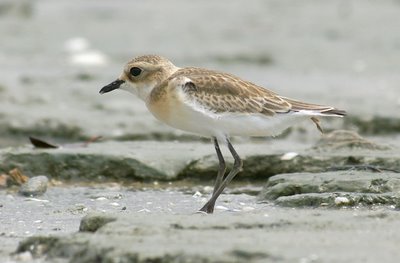
This Lesser Sandplover is still largely in juvenile plumage. The crown feathers, as well as the mantle and scapulars, have mud-brown centres with quite broad creamy fringes. The lovely peach-toned feathers on the lores, ear coverts, supercilium and sides of the breast are also juvenile feathers. If you look carefully at the scapulars, you can see about 5 or 6 feathers on the lower row which are plain mud-brown, without the paler fringes. These are fresh '1st autumn' feathers. (Click on the photo to see an enlarged version.)
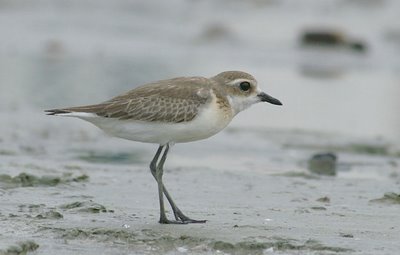
This bird is also a Lesser Sand Plover, and also one of this year's hatch. However, it has pretty much completed a body and head moult, replacing the brighter juvenile feathers with duller adult-like ones. The wing coverts have not been replaced, but don't look as bright as on the preceding bird because, being older, the pale fringes are more worn away.
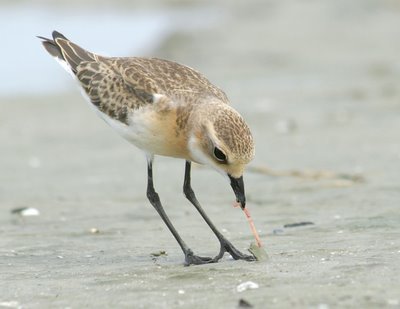
I was very entertained by this juv Lesser Sand Plover's efforts to extract a worm from its hole. The Plover stretched up to its fullest height and leant back with all its might, but the worm managed to hang on. I believe they have stiff hairs along their body angled upwards, so it must be rather like trying to pull an arrow out of a tree. You can clearly see that the feet of this species have tiny webs between the bases of the toes. This feature is called 'semi-palmation', and is a key identification for some species.

In the end, this was all the plover got for its efforts, and the worm presumably lived to fight another day. Maybe an older, more experienced plover would have grasped the worm lower down its body? I'll have to watch out to see.
No comments:
Post a Comment